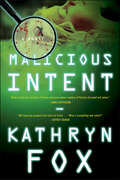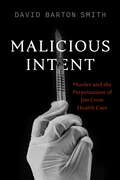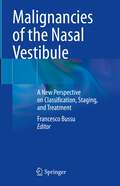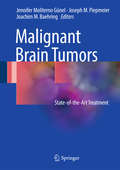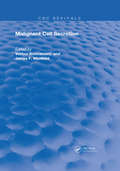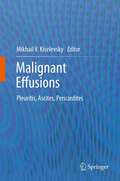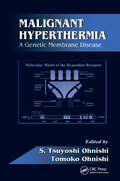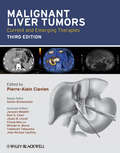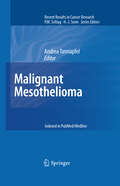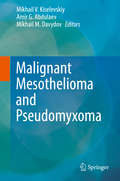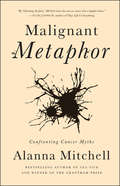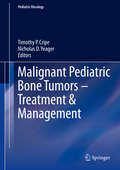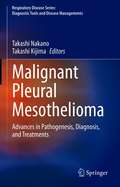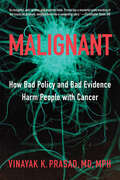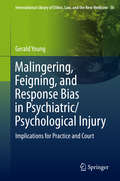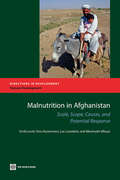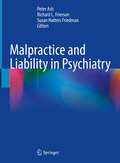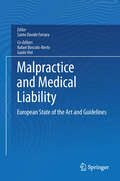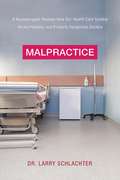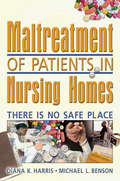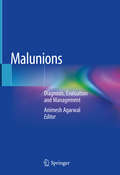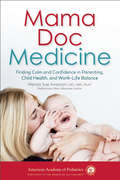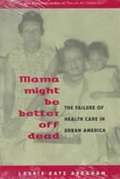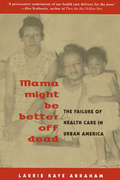- Table View
- List View
Malice Aforethought: The Story Of A Commonplace Crime
by Francis IlesA classic crime masterpiece - and major TV adaptationOn a balmy summer's day in 1930 the great and the good of the county are out in force for the annual, much-anticipated tennis party at the Bickleighs, although not everyone has much enthusiasm for the game. The tennis party exists for other reasons - and charmingly mannered infidelity is now the most popular pastime in the small but exclusive Devonshire hamlet of Wyvern's Cross.Which is why, in his own garden, the host, Dr Edmund Bickleigh, is desperately fighting to conceal the two things on his mind: a mounting passion for Gwynfryd Rattery - and the certain conviction that he is going to kill his wife . . .
Malicious Intent: A Novel
by Kathryn FoxA gripping and powerful new thriller -- the debut of a stunning new voice in suspense fiction -- and the first appearance of a tough and remarkable investigator, pathologist, and forensic physician, Dr. Anya Crichton.The only female freelancer in the male-dominated field, pathologist Dr. Anya Crichton will take any work she can find to pay child support and her mortgage, get her new business off the ground, and battle her ex-husband for custody of their three-year-old son. Things turn around rapidly, however, when her expert forensic evidence is instrumental in winning a high-profile case -- and new work offers start pouring in.But Anya's investigation into the drug overdose of a young Lebanese girl is raising troubling questions. Startling coincidences between this sad and tragic death and a series of seemingly unrelated suicides that Anya is also examining at the urging of her friend and colleague, detective sergeant Kate Farrer, suggest that there's a monumental evil at work in the shadows. With each scalpel cut, Anya Crichton's forensic prowess and deductive brilliance are pulling her relentlessly toward a sinister plot and a devastating truth -- and once she enters the lethal darkness, she may never again see the light of day.
Malicious Intent: Murder and the Perpetuation of Jim Crow Health Care
by David Barton Smith&“Do we want to perpetuate a Jim Crow health system?&” A brilliant, idealistic physician named Jean Cowsert asked that question in Alabama in 1966. Her answer was no—and soon after, she died under suspicious circumstances. Unearthing the truth of Cowsert&’s life and death is a central concern of David Barton Smith&’s Malicious Intent. Unearthing the grim history of our health care system is another. Race-related disparities in American death rates, exacerbated once again by the COVID-19 pandemic, have persisted since the birth of the modern US medical system a century ago. A unique but perpetually unequal history has prevented the United States from providing the kind of health care assurances that are taken for granted in other industrialized nations. The underlying story is one of political, medical, and bureaucratic machinations, all motivated by a deliberate Jim Crow systemic design. In Malicious Intent, David Barton Smith traces the Jean Cowsert story and the cold case of her death as a through line to explain the construction and fulfillment of an unequal health care system that would rather sacrifice many than provide for Black Americans. Cowsert&’s suspicious death came at a key moment in the struggle for universal health care in the wealthiest country on earth. Malicious Intent is a history of those failed efforts and a story of selective amnesia about one doctor&’s death and the movement she fought for.
Malignancies of the Nasal Vestibule: A New Perspective on Classification, Staging, and Treatment
by Francesco BussuThis book provides up-to-date information on nasal vestibule malignancies, outlining the specific clinical history and pattern of spread. It also describes the flaws in TNM staging, which can be attirbuted to factors ranging from the anatomy to the definition of the main prognostic parameters.Nasal vestibule malignancies are associated with a peculiar oncological history, but there are also clear issues related to the reconstructive phase following ablative surgery due to the anatomic peculiarities. Such issues deeply impact the cosmetic and functional results, and hence the quality of life of surviving patients.Additionally, the book describes novel evidence on treatment outcomes for these malignancies in terms of both oncological and functional results. It proposes a new standard based on interstitial HDR brachytherapy for the primary lesion and on surgery for regional metastases.The book appeals to a wide readership, ranging from otolaryngologists, to radiation and clinical oncologists, dermatologists, plastic surgeons and maxillo-facial surgeons.
Malignant Brain Tumors
by Jennifer Moliterno Gunel Joseph M Piepmeier Joachim M. BaehringThis text addresses all aspects of patient evaluation and care. This includes new findings in imaging that provide a better understanding of the extent of the lesion as well as its relationship with critical neuroanatomic function. The evolution of intraoperative imaging, functional brain mapping and technology to identify tumor from brain is covered. This has significantly improved the ability of surgeons for safer and more aggressive tumor removal. More importantly, a better understanding of tumor biology and genomics has created an opportunity to significantly revise tumor classification and better select optimal therapy for individual patients. The text covers novel and innovative treatment options including immunotherapy, tumor vaccines, antiangiogenic agents and personalized cancer treatment. In addition, novel agent delivery techniques are covered to offer the potential for increasing the effectiveness of treatment by delivering active agents directly where they are needed most. Malignant Brain Tumors: State-of-the-art Treatment provides a comprehensive overview of treatment for malignant gliomas, organized by subspecialized discipline and will prove useful by updating physicians on new therapeutic paradigms and what is on the horizon for the near future. This text will be informative for surgeons, oncologists, neurologists, residents and students who treat these patients as well as those who are training for a career in managing patients with these challenging tumors.
Malignant Cell Secretion (Routledge Revivals)
by Velibor Krsmanovic James F. WhitfieldFirst Published in 1990, this book offers a full, comprehensive guide into the nature of cells. Carefully compiled and filled with a vast repertoire of notes, pictures, and references this book serves as a useful reference for Students of Medicine, Microbiology, and other practitioners in their respective fields.
Malignant Effusions: Pleuritis, Ascites, Pericardites
by Mikhail V. KiselevskyMalignant effusions (pleurites, ascites and pericarditis) are some of the most frequent manifestations of dissemination process of malignant tumors. Accumulation of the malignant fluid in serous cavities results in impairment of respiratory and cardiac functions, however long-term evacuation of the fluid leads to severe disorders of homeostasis that may directly cause the patient's death. The aim of this comprehensive book is to provide detailed information of pathogenesis and management of malignant effusions. The current book focuses on three of these categories: pleuritis, acsites and pericarditis. This book, written by recognized experts in the field, provides a detailed overview of current knowledge on this subject. The presented book reports valuable information about malignant effusions to basic and clinical medical specialists in academia, practice, as well as industry. The main topics considered include contemporary diagnostic approaches and modern therapeutic strategies, including conventional drugs, methods of intracavitary adoptive immunotherapy, chemotherapy and hyperthermia, commercial and experimental drugs being still under study. The material is presented in an easy to read and understandable language and uses a plethora of tables and figures. This book is aimed at oncologists, as well as phthisiatrician, surgeons, therapists and physicians of various specializations, who have to make diagnosis and treat effusions during their professional activity, and it will be undoubtedly helpful for interns, post-graduates and Ph.D. fellows of medical centers.
Malignant Hyperthermia: A Genetic Membrane Disease (Membrane Linked Diseases Ser. #3)
by S. Tsuyoshi Ohnishi Tomoko OhnishiThis book is dedicated to those who died of malignant hyperthermia and to their families. It contains cases studies that would be helpful for anesthesiologists, surgeons, physiologists, molecular biologists, biophysicists, biochemists, pathologists, students, and post doctoral fellows.
Malignant Liver Tumors: Current and Emerging Therapies
by Jean-Nicolas Vauthey Jacques Belghiti Josep M. Llovet Chung-Mau Lo Michael A. Morse Ravi S. Chari Stefan Breitenstein Tadatoshi TakayamaThis comprehensive and critical review of current and established treatment modalities for malignant liver tumors is designed to help you sort through the proliferation of competitive approaches and choose the best treatment options for your patient. Dr. Clavien and his contributors consider all the options – radiological, surgical, pharmaceutical, and emerging/novel therapies – and help you find the best single or combined therapy. Building on the success of the previous edition, this extremely thorough revision: features a new section on Guidelines for Liver Tumors, where you will find specific strategies for treating common liver malignancies; the guidelines were prepared by the Associate Editors and take into account national and international society guidelines reflects actual practice by taking a multidisciplinary approach, with contributions from international experts who have extensive experience with this patient population achieves comprehensive and balanced coverage by having each chapter reviewed by the Editor, Deputy Editor, two Associate Editors, and at least one external reviewer includes 16 new chapters that cover liver anatomy, histologic changes in the liver, epidemiology and natural history of HCC, CCC and colorectal liver metastases, strategies of liver resection, and economic aspects as well as novel therapies facilitates the kind of daily interaction among hepatologists, hepatic surgeons, medical oncologists, radiotherapists, and interventional radiologists that is essential when treating patients with complex liver malignancies In 44 chapters organized into six major sections, the book covers the full range of liver tumors. The perfect blend of evidence and experience, Malignant Liver Tumors: Current and Emerging Therapies, 3rd Edition, illuminates the path to better patient care.
Malignant Mesothelioma
by Andrea TannapfelMalignant mesothelioma is an aggressive and fatal neoplasm of serous membranes that still shows a rising incidence worldwide. This book covers all the important aspects of the disease by bringing together contributions from selected experts in the fields of epidemiology, imaging, pathological diagnosis, therapy, genetics, and screening. Special emphasis is placed on the latest diagnostic techniques and current therapy standards. In addition, the mineralogy of asbestos is reviewed and clear advice is included on the analysis of tissue mineral fiber content. By providing a compact, scientifically based, and up-to-date overview of the management of malignant mesothelioma, this volume will be invaluable for all clinicians and pathologists who are engaged in the diagnosis and treatment of the disease or in related research.
Malignant Mesothelioma and Pseudomyxoma
by Mikhail V. Kiselevskiy Amir G. Abdulaev Mikhail M. DavydovThe book discusses a vital problem of diagnostics and treatment of peritoneal malignancies, pseudomyxoma and malignant mesothelioma, which is still insufficiently developed. Compared to similar, earlier editions, this volume importantly presents cutting-edge approaches and up-to-date diagnostic methods.The authors place special emphasis on morphological/pathological characteristics of these tumors involving immunodiagnostic techniques, and a chapter on the immunotherapy of mesothelioma and pseudomyxoma will be of special interest to readers.Fully illustrated, the book will present an algorithm of diagnostics and complex treatment of these tumors.
Malignant Metaphor: Confronting Cancer Myths
by Alanna Mitchell“Clear medical explanations . . . will bring comfort to those readers and their loved ones facing a cancer diagnosis” (Publishers Weekly). A Finalist for the Lane Anderson Award for Science Writing Alanna Mitchell explores the facts and myths about cancer in this powerful book, as she recounts her family’s experiences with the disease. When her beloved brother-in-law John is diagnosed with malignant melanoma, Alanna throws herself into the latest clinical research, providing us with a clear description of what scientists know of cancer and its treatments. When John enters the world of alternative treatments, Alanna does, too, looking for the science in untested waters. She comes face to face with the misconceptions we share about cancer, which are rooted in blame and anxiety, and opens the door to new ways of looking at our most-feared illness. Beautifully written, Malignant Metaphor is a compassionate and persuasive book that has the power to change the conversation about cancer. “Mitchell’s research is rooted in science, while her writing remains grippingly personal.” ―Quill & Quire
Malignant Pediatric Bone Tumors - Treatment & Management
by Timothy P. Cripe Nicholas D. YeagerThis book describes in detail current best practice in the diagnosis and treatment of malignant pediatric bone tumors and also discusses other important aspects of management. Clinical assessment, the role of different imaging modalities and choice of biopsy procedure are explained and an individual chapter is devoted to diagnostic pathology. The treatment-oriented chapters offer in-depth descriptions of chemotherapeutic regimens, radiation therapy, limb-salvage options and amputation-related issues and in addition consider the approach to lung nodules, the role of biomarkers, off-therapy monitoring and the treatment of relapse. Psychosocial impacts and needs are addressed and guidance provided on nursing during treatment and rehabilitation following orthopaedic surgery. Closing chapters evaluate emerging therapies and discuss disparate aspects of survivorship. The authors are acknowledged experts and include many contributors from the Nationwide Children's Hospital, a leading pediatric care facility in the United States.
Malignant Pleural Mesothelioma: Advances in Pathogenesis, Diagnosis, and Treatments (Respiratory Disease Series: Diagnostic Tools and Disease Managements)
by Takashi Nakano Takashi KijimaThis book provides essential information on recent advances in molecular genetics, epidemiology, translational research, and the latest results of clinical trials on mesothelioma. Significant progress has been made in understanding mesothelioma biology, and in developing new therapies for this refractory tumor, malignant pleural mesothelioma (MPM). Not only does this volume summarize the latest research-based data on the disease; it also shares insights into future research directions.The book consists of 5 themed sections on: epidemiology, pathogenesis, screening and early detection, molecular genetics, and clinical aspects and management. Several chapters focus on new trends in the field, e.g. immune therapy and identification of biomarkers, molecular oncogenesis including genetic susceptibility, and molecular diagnostic pathology. The book also highlights new cancer treatment approaches, such as immunotherapy based on immune checkpoint inhibitors, which has meant a paradigm shift in other types of cancer, and given some hope to MPM patients. In turn, it discusses recent molecular pathological studies on mesothelioma, which claim to offer more accurate classifications than traditional morphology and immunohistochemistry-based approaches. All of these cutting-edge analyses provide the basis for a closing discussion on future developments and research directions.Malignant Pleural Mesothelioma - Advances in Pathogenesis, Diagnosis, and Treatments has been edited and authored by respected researchers and will be of interest to medical, surgical and radiation oncologists; pulmonologists; pathologists and basic researchers alike. Since the disease represents a significant diagnostic and therapeutic challenge, scientists and clinicians from learners to experts, as well as fellows in training in these subspecialties, will value this book.
Malignant: How Bad Policy and Bad Evidence Harm People with Cancer
by Vinayak K. PrasadHow hype, money, and bias can mislead the public into thinking that many worthless or unproven treatments are effective.Each week, people read about new and exciting cancer drugs. Some of these drugs are truly transformative, offering major improvements in how long patients live or how they feel—but what is often missing from the popular narrative is that, far too often, these new drugs have marginal or minimal benefits. Some are even harmful. In Malignant, hematologist-oncologist Dr. Vinayak K. Prasad writes about the many sobering examples of how patients are too often failed by cancer policy and by how oncology is practiced. Throughout this work, Prasad illuminates deceptive practices which• promote novel cancer therapies long before credible data are available to support such treatment; and• exaggerate the potential benefits of new therapies, many of which cost thousands and in some cases hundreds of thousands of dollars.Prasad then critiques the financial conflicts of interest that pervade the oncology field, the pharmaceutical industry, and the US Food and Drug administration. This is a book about how the actions of human beings—our policies, our standards of evidence, and our drug regulation—incentivize the pursuit of marginal or unproven therapies at lofty and unsustainable prices. Prasad takes us through how cancer trials are conducted, how drugs come to market, and how pricing decisions are made, asking how we can ensure that more cancer drugs deliver both greater benefit and a lower price. Ultimately, Prasad says, • more cancer clinical trials should measure outcomes that actually matter to people with cancer;• patients on those trials should look more like actual global citizens;• we need drug regulators to raise, not perpetually lower, the bar for approval; and• we need unbiased patient advocates and experts.This well-written, opinionated, and engaging book explains what we can do differently to make serious and sustained progress against cancer—and how we can avoid repeating the policy and practice mistakes of the past.
Malingering, Feigning, and Response Bias in Psychiatric/ Psychological Injury
by Gerald YoungThis book is a comprehensive analysis of the definitions, concepts, and recent research on malingering, feigning, and other response biases in psychological injury/ forensic disability populations. It presents a new model of malingering and related biases, and develops a "diagnostic" system based on it that is applicable to PTSD, chronic pain, and TBI. Included are suggestions for effective practice and future research based on the literature reviews and the new systems, which are useful also because they can be used readily by psychiatrists as much as psychologists. In Malingering, Feigning, and Response Style Assessment in Psychiatric/Psychological Injury, Dr. Young ambitiously sets out to articulate and synthesize the polarities involved in the assessment of response styles in psychological disabilities, including PTSD, pain, and TBI. He does so thoroughly and very even-handedly, neither minimizing the degree that outright faking can be found in substantial numbers of examinees, nor disregarding the possibility that there can be causes for validity test failure other than malingering. He reviews the prior systems for classifying evidence of malingering, and proposes his own criteria for feigned PTSD. These are conservative and well-grounded in the prior literature. Finally, the book contains dozens of very recent references, giving testament to Dr. Young's immersion in the personal injury literature, as might be expected from his experience as founder and Editor in Chief for Psychological Injury and the Law. Reviewer: Steve Rubenzer, Ph. D. , ABPP Board Certified Forensic Psychologist
Malnutrition in Afghanistan: Scale, Scope, Causes, and Potential Response
by Emily Levitt Luc Laviolette Kees Kostermans Nkosinathi MbuyaSouth Asia has the highest rates of malnutrition and the largest number of malnourished women and children in the world. Childhood malnutrition is the main cause of child mortality-one-third of all child deaths are due to the underlying cause of malnutrition. For the children who survive, malnutrition results in lifelong problems by severely reducing a child's ability to learn and to grow to his or her full potential. Malnutrition directly leads to less productive adults and thus to weaker national economic performance. The negative impact of malnutrition on a society's productivity and a nation's long-term development is difficult to underestimate. Malnutrition is a key development priority for the World Bank's South Asia region. The Bank intends to increase its commitment to reducing malnutrition in the region. As a first step, Bank staff are preparing a series of country assessments such as Malnutrition in Afghanistan. These assessments will be useful for governments and development partners committed to scaling up effective, evidence-based interventions to reduce malnutrition in their countries. Conclusive evidence shows that a multisectoral planning approach, followed by actions in the various sectors, is the most successful method to improve a populations' nutrition. Malnutrition in Afghanistan provides the background analysis for the development of a comprehensive nutrition action plan. The timing of this report is propitious. The international communities' interest in the developmental benefits of nutrition programming is high. This analytical report is part of a broader effort by the World Bank South Asia region to increase investments in nutrition, recognizing that good nutrition is important to economic growth and development, and because investing in well-proven nutrition interventions pays high dividends in poverty reduction and national economic development.
Malpractice and Liability in Psychiatry
by Peter Ash Richard L. Frierson Susan Hatters FriedmanThis book comprehensively educates psychiatrists about malpractice and other liability. It is written to also specifically assist psychiatrists who are sued or are involved in other complaints. The first two sections discuss malpractice law and the litigation process; the litigation section mainly addresses some of the more emotionally charged issues, including do’s and don’ts, how an attorney will be looking at the case, the defendant doctor’s testifying at deposition and trial, and the stress of being sued. The subsequent three sections address specific topics that give rise to liability, with each section taking a different perspective such as risks in particular clinical, by practice site, and special issues, including practice in special situations such as the current pandemic. The final section discusses other forms of liability, such as complaints to medical boards or professional association ethics committees. An exceptional work, Malpractice and Liability in Psychiatry, functions as both a go-to handbook and all-encompassing read on the aforementioned topics.
Malpractice and Medical Liability
by Guido Viel Rafael Boscolo-Berto Santo Davide FerraraMedical responsibility lawsuits have become a fact of life in every physician's medical practice. However, there is evidence that physicians are increasingly practising defensive medicine, ordering more tests than may be necessary and avoiding patients with complicated conditions. The modern practice of medicine is increasingly complicated by factors beyond the traditional realm of patient care, including novel technologies, loss of physician autonomy, and economic pressures. A continuing and significant issue affecting physicians and the healthcare system is malpractice. In the latter half of the 20th century, there was a major change in the attitude of the public towards the medical profession. People were made aware of the huge advances in medical technology, because health problems increasingly tended to attract media interest and wide publicity. Medicine is a victim of its own success in this respect, and people are now led to expect the latest techniques and perfect outcomes on all occasions. This burst of technology and hyper-specialization in many fields of medicine means that each malpractice claim is transformed into a scientific challenge, requiring specific preparation in analysis and judgment of the clinical case in question. The role of legal medicine becomes more and more peculiar in this judicial setting, often giving rise to erroneous interpretations and hasty scientific verdicts, but guidelines on the methodology of ascertainments and criteria of evaluation are lacking all over the world.The aim of this volume is to clarify the steps required for sequential in-depth analysis of events and consequences of medical actions, in order to verify whether, in the presence of damage, errors or non-observance of rules of conduct by health personnel exist, and which causal values and links of their hypothetical misconduct are involved.
Malpractice: A Neurosurgeon Reveals How Our Health Care System Harms Patients and Protects Dangerous Doctors
by John Bechtel Lawrence SchlachterIn 1991, the Institute of Medicine released a landmark report, which revealed that as many as 98,000 patients were dying every year owing to avoidable medical error. More recent research indicates that estimate was, if anything, a drastic understatement of the patient-safety epidemic in the US health care system.In Malpractice, neurosurgeon and attorney Dr. Larry Schlachter makes a case that most patients enter the system without any idea of the risks they face, due to a medical culture that denies there is a patient safety problem. He argues that medical culture actively avoids transparency, perpetuates an atmosphere of blind deference to doctors, and protects dangerous doctors from any accountability.Drawing on 23 years of experience, Dr. Schlachter provides unbelievable stories that illustrate the host of risks patients face whenever they seek diagnostic evaluation or go under the knife. This book provides an all-access pass to the inner sanctums of the health care citadel, exposing the cultural flaws that fuel doctor's egos and outlining the steps every patent should take to protect himself or herself.
Maltreatment of Patients in Nursing Homes: There Is No Safe Place
by Harold G Koenig Diana Harris"Abuse, although often not detected or reported, existed in every facility we surveyed. It is a serious problem."Old, weak, and often cognitively impaired, nursing home patients can be easy targets for physical, psychological, material, and financial mistreatment at the hands of those entrusted with their care, safety, and well-being. Maltreatment of Patients in Nursing Homes: There Is No Safe Place examines the dark side of nursing homes, where not every employee has the commitment of Mother Theresa. This groundbreaking book applies criminological theory to help develop practical methods of controlling abuse and presents the results of the first and only nationwide study on the theft of patients&’ belongings, a form of abuse too often ignored by the nursing home industry. Maltreatment of Patients in Nursing Homes surveys employees, administrators, and family members of patients in 47 nursing homes throughout the United States. Their responses provide invaluable insights on a wide range of topics, including the social and psychological factors that cause different types of abuse, characteristics of nursing home patients and employees, the bureaucracy of nursing homes, victimization rates, workforce issues of nursing home aides, and federal regulations for nursing homes. The information gained from the surveys forms the basis for detailed recommendations for creating a safer environment and reducing all forms of abuse, including theft-prevention training programs, background checks and improved screening of potential employees, education and advocacy for current staff, and the reform of federal regulations.Maltreatment of Patients in Nursing Homes examines: types of physical abuse (restraints, sexual abuse, neglect) the who, what, and why of nursing home theft types of financial abuse (trust accounts, bank accounts, improper charges for services and drugs, identity theft) types of psychological abuse (abandonment, segregation, childlike treatment, verbal abuse) effects of psychological abuse (depression, learned helplessness, psychiatric disorders) reasons for abuse by employees (staff turnover, job burnout, job dissatisfaction, caregiver stress)One of the few books to deal with abuse of the elderly outside a domestic setting, Maltreatment of Patients in Nursing Homes: There Is No Safe Place interprets and analyzes abuse to provide new ways of thinking about this growing problem and new methods of preventing it from growing any more widespread.
Malunions: Diagnosis, Evaluation and Management
by Animesh AgarwalProviding a comprehensive presentation of the diagnosis, evaluation and management of malunions, this generously illustrated text details the current principles, surgical techniques and approaches with these challenging clinical situations. Since each malunion can be fairly specific, the treatment regimens provide guidelines to effectively approach such problems. Opening with a brief overview of the principles of malunions, the remainder of the book is divided by anatomical area and provides evidence-based recommendations, case examples, and preferred treatment/algorithms for both the upper and lower extremities, including the clavicle, proximal and distal humerus, hand and wrist, proximal and distal femur, and tibia and ankle, as well as the pelvis and acetabulum. Specialized circumstances are also discussed, including periprosthetics and joint replacement.Although not every single treatment option is described for every single anatomical area and type of injury, Malunions is an excellent resource for orthopedic trauma surgeons, residents and students, not only for managing these common yet complex problems but also in preventing malunions from occurring by avoiding surgical causes and mitigating patient risk factors.
Mama Doc Medicine
by Wendy Sue Swanson"Parents want to do what is right," explains Mama Doc blogger and pediatrician Wendy Sue Swanson, MD, MBE, FAAP. Yet because many parents find that defining what's right can sometimes be elusive. Dr Swanson has created this innovative guide to help.Based on the popular SeattleMamaDoc blog, Mama Doc Medicine: Finding Calm and Confidence in Parenting, Child Health, and Work-Life Balance is a timely collection of almost 100 entries grouped under the following headings:Part 1: PreventionPart 2: Socia-Emotional SupportPart 3: ImmunizationsPart 4: Work-Life Balance Dr. Swanson's experience as a mother and a physician provides this book with simple answers to the "how," "what," "why," and "who" questions of parenting.
Mama Might Be Better Off Dead: The Failure of Health Care in Urban America
by Laurie Kaye Abraham"Mama Might Be Better Off Dead" is an unsettling, profound look at the human face of health care. Both disturbing and illuminating, it immerses readers in the lives of four generations of a poor, African-American family beset with the devastating illnesses that are all too common in America's inner-cities. The story takes place in North Lawndale, a neighborhood that lies in the shadows of Chicago's Loop. Although surrounded by some of the city's finest medical facilities, North Lawndale is one of the sickest, most medically underserved communities in the country. Headed by Jackie Banes, who oversees the care of a diabetic grandmother, a husband on kidney dialysis, an ailing father, and three children, the Banes family contends with countless medical crises. From visits to emergency rooms and dialysis units, to trials with home care, to struggles for Medicaid eligibility, Abraham chronicles their access (or lack of access) to medical care. Told sympathetically but without sentimentality, their story reveals an inadequate health care system that is further undermined by the direct and indirect effects of poverty. When people are poor, they become sick easily. When people are sick, their families quickly become poorer. Embedded in the family narrative is a lucid analysis of the gaps, inconsistencies, and inequalities the poor face when they seek health care. This book reveals what health care policies crafted in Washington, D. C. or state capitals look like when they hit the street. It shows how Medicaid and Medicare work and don't work, the Catch-22s of hospital financing in the inner city, the racial politics of organ transplants, the failure of childhood immunization programs, the vexed issues of individual responsibility and institutional paternalism. One observer puts it this way: "Show me the poor woman who finds a way to get everything she's entitled to in the system, and I'll show you a woman who could run General Motors. " Abraham deftly weaves these themes together to make a persuasive case for health care reform while unflinchingly presenting the complexities that will make true reform as difficult as it is necessary. "Mama Might Be Better Off Dead" is a book with the power to change the way health care is understood in America. For those seeking to learn what our current system of health care promises and what it delivers, it offers a place for the debate to begin.
Mama Might Be Better Off Dead: The Failure of Health Care in Urban America
by Laurie Kaye AbrahamMama Might Be Better Off Dead is an unsettling, profound look at the human face of health care. Both disturbing and illuminating, it immerses readers in the lives of four generations of a poor, African-American family beset with the devastating illnesses that are all too common in America's inner-cities. The story takes place in North Lawndale, a neighborhood that lies in the shadows of Chicago's Loop. Although surrounded by some of the city's finest medical facilities, North Lawndale is one of the sickest, most medically underserved communities in the country. Headed by Jackie Banes, who oversees the care of a diabetic grandmother, a husband on kidney dialysis, an ailing father, and three children, the Banes family contends with countless medical crises. From visits to emergency rooms and dialysis units, to trials with home care, to struggles for Medicaid eligibility, Abraham chronicles their access (or lack of access) to medical care. Told sympathetically but without sentimentality, their story reveals an inadequate health care system that is further undermined by the direct and indirect effects of poverty. When people are poor, they become sick easily. When people are sick, their families quickly become poorer. Embedded in the family narrative is a lucid analysis of the gaps, inconsistencies, and inequalities the poor face when they seek health care. This book reveals what health care policies crafted in Washington, D. C. or state capitals look like when they hit the street. It shows how Medicaid and Medicare work and don't work, the Catch-22s of hospital financing in the inner city, the racial politics of organ transplants, the failure of childhood immunization programs, the vexed issues of individual responsibility and institutional paternalism. One observer puts it this way: "Show me the poor woman who finds a way to get everything she's entitled to in the system, and I'll show you a woman who could run General Motors." Abraham deftly weaves these themes together to make a persuasive case for health care reform while unflinchingly presenting the complexities that will make true reform as difficult as it is necessary. Mama Might Be Better Off Dead is a book with the power to change the way health care is understood in America. For those seeking to learn what our current system of health care promises and what it delivers, it offers a place for the debate to begin.

